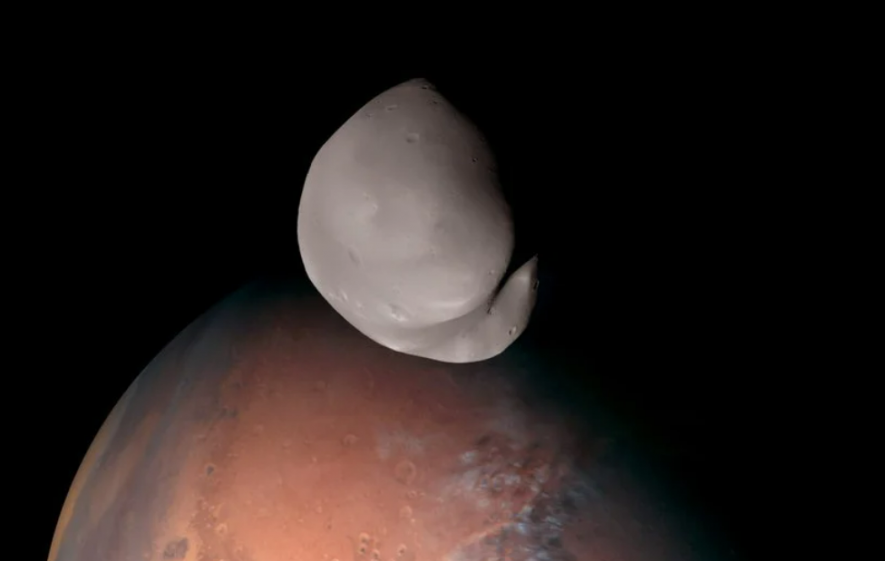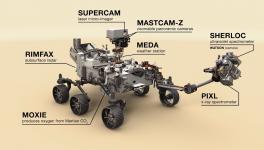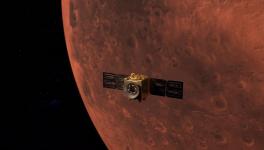UAE Mars Mission Captures Closest and Most Detailed View of Mars Moon Deimos

New Delhi: Deimos is a natural satellite of Mars, the outermost and smaller than Phobos, the other Martian satellite. The closest view of Deimos has now been captured by the Emirates Mars Mission (EMM). The United Arab Emirates (UAE) Mars mission’s spacecraft named Amal or Hope has flown past the smaller Martian moon, a release by UAE authority said on April 24.
Scientists have claimed that the observations substantiate the theory that Mars's moons formed along with the planet. This means the Martian moons may have a planetary origin rather than a mere asteroid caught in the planet's orbit. It is worth mentioning here that one of the conventional theories about Mars’ moons is that they are simply captured asteroids in the planet’s orbit.
The two moons of Mars, Deimos and Phobos, are irregularly shaped. The more prominent among them, Phobos, has a diameter of 17 miles at its most comprehensive portion and also revolves around the red planet closer, at an altitude of around 3700 miles. Deimos is the smaller, with a diameter of only 9 miles at its most comprehensive portion and revolves around the planet at an altitude of 15,000 miles. Due to its small size, scientists thought that Deimos might be an asteroid captured by Mars.
The Hope spacecraft of the EMM entered the orbit of Mars in February 2021, and on March 10, Hope got as close as 60 miles above the surface of Deimos. Reportedly, the earlier approach to the moon closer than this was by the Viking2 orbiter of the National Aeronautics and Space Administration (NASA) in 1977. However, NASA’s mission was equipped with only primitive instruments and cameras. On the other hand, the EMM mission has advanced instruments and could produce high-resolution images of Deimos. The mind-blowing images of Deimos with Mars in the background, as captured by EMM’s Hope spacecraft, can be seen in this article in Nature.
The EMM team used all three instruments onboard the spacecraft to take readings of the Mars moon. The scientists attempted to probe the composition of Deimos, and they found that the amount of its carbon and organic components are more similar to Mars than any asteroid. Scientists could observe lights of all wavelengths spanning from infrared to ultraviolet. Hessa Al Matroushi, the science lead of the EMM, opined that from the spectral analysis of the moon's composition, it looks like Mars more than an asteroid.
Notably, the Mars moon is also tidally locked, as the moon of the Earth. Tidal locking means that only one side or face of the moon is always turned towards Mars, as our moon does to Earth. The Hope spacecraft could also obtain views of the far side (the side that always faces away from Mars) for the first time. Hope’s orbit is unusually long, reaching 40000 kilometres above Mars’ surface. This capability of the spacecraft enabled it to capture the far side of Deimos. Importantly, due to the elongated orbit of the Hope spacecraft, it could not reach the other satellite of Mars, Phobos, as it revolves around the planet at a much lesser altitude.
Hope will continue its mission till 2024 and will observe Deimos throughout 2023.
The primary mission of EMM was to study the weather pattern and atmosphere of Mars. Along with this, now the mission plans to observe Deimos multiple times. “We don’t want to get a one-time observation of Deimos. We knew we wanted more,” commented Hessa Al Matroushi in a statement. How the Mars moons were born and since when have they been orbiting, the planet is an active field of research, in which the UAE mission seems to contribute more.
Get the latest reports & analysis with people's perspective on Protests, movements & deep analytical videos, discussions of the current affairs in your Telegram app. Subscribe to NewsClick's Telegram channel & get Real-Time updates on stories, as they get published on our website.

















